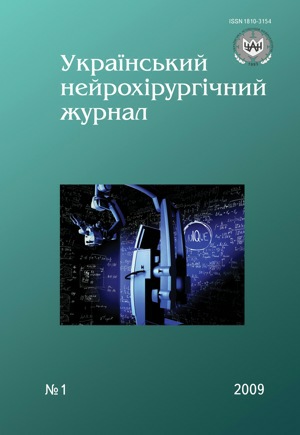Analysis of causes of unsuccessful microvascular decompression operations and recurrences of hyperactive dysfunction syndromes of cranial nerves
DOI:
https://doi.org/10.25305/unj.108813Keywords:
hyperactive dysfunction syndromes, cranial nerves, microvascular decompression surgery, recurrences, herpes viruses, immunodepressionAbstract
An analysis of 7 cases of ponto-cerebellum corner structures revision after unsuccessful CN MVD for HDS in early terms with positive results of a repeat operation in 6 (85.7%) patients is presented; as well as 38 (11.5%) cases of HDS recurrence (out of 330 patients), 9 (2.7%) of whom were operated on in the terms from 6 months to 5 years with positive immediate result and subsequent partial recurrence in 2 (22,2%) cases under follow-up.
In 19 (50%) out of 38 patients with HDS recurrence virologic and immunological tests were done, which necessitated the use of antivirus and immunocorrective therapy with a positive result in 15 (78.9%) patients, 4 (21.1%) — were operated on again later.
Virologic and immunological investigations and therapy based on pathogenesis are validated in case of HDS. In case of unsuccessful MVD of CN or HDS recurrence ponto-cerebellum corner structures should be revised with the aim of repeat decompression or CN neurolysis.
References
Зозуля Ю.П., Лісяний М.І., Федірко В.О. та ін. Синдроми дисфункції черепних нервів за гіперактивним типом: фактори патогенезу та їх значення для лікувальної тактики // Укр. мед. часопис. — 2008. — №3(65). — С.111–116.
Федірко В.О., Васильєва І.Г., Кононенко В.В. та ін. Больові синдроми в ділянці обличчя, голови, шиї, пов’язані з герпес-вірусами // Анали Мечниківського Інституту. — 2003. — №4–5. — С.60–66.
Barker F.G. II, Jannetta P.J., Bissonette D.J. et al. The long-term outcome of microvascular decompression for trigeminal neuralgia // New Engl. J. Med. — 1996. — V.334. — P.1077–1083.
Chen J.-F., Lee S.-T., Lui T.-N. et al. Granuloma after microvascular decompression for trigeminal neuralgia // Surg. Neurol. — 2000. — V.53. — P.275–280.
Eide P.K., Stubhaug A. Relief of trigeminal neuralgia after percutaneous retrogasserian glycerol rhizolysis is dependent on normalization of abnormal temporal summation of pain, without general impairment of sensory perception // Neurosurgery. — 1998. — V.43, N3. — P.462–473.
Jannetta P.J. Neurovascular compression in cranial nerves and systemic disease // Ann. Surg. — 1980. — V.192. — P.518–525.
Ko Y., Yi H.-J., Kim Y.-S. et al. Results of microvascular decompression of the cochlear nerve for intractable tinnitus // J. Neurosurg. — 2002. — V.96. — P.443.
Kondo A. Follow-up results of microvascular decompression in trigeminal neuralgia and hemifacial spasm // Neurosurgery. — 1997. — V.40, N1. — P.46–51.
Lee S.H., Levy E.I., Scarrow A.M. et al. Recurrent trigeminal neuralgia attributable to veins after microvascular decompression // Neurosurgery. — 2000. — V.46, N2. — P.356–362.
Levy E.I., Clyde B., Mc Laughlin M.R., Jannetta P.J. Microvascular decompression of the left lateral medulla oblongata for severe refractory neurogenic hypertension // Neurosurgery. — 1998. — V.43, N1. — P.1–9.
Liao J.J., Cheng W.C., Chang C.N. et al. Reoperation for recurrent trigeminal neuralgia after microvascular decompression // Surg. Neurol. — 2000. — V.53, N3. — P.281–287.
Lovely T.J., Getch C.C., Jannetta P.J. Delayed facial weakness after microvascular decompression of cranial nerve VII // Surg. Neurol. — 1998. — V.50. — P.449–452.
Maesawa S., Salame C., Flickinger J.C. et аl. Clinical outcomes after stereotactic radiosurgery for idiopathic trigeminal neuralgia // J. Neurosurg. — 2001. — V.94. — P.14–20.
Maher C.O., Pollock B.E. Radiation induced vascular injury after stereotactic radiosurgery for trigeminal neuralgia: case report // Surg. Neurol. — 2000. — V.54. — P.189–193.
Sheehan J., Pan H.C., Stroila M., Steiner L. Gamma-knife surgery for trigeminal neuralgia: outcomes and prognostic factors / J. Neurosurg. — 2005. — V.102. — P.434–441.
Sindou M., Howeidy T., Acevedo G. Anatomical observations during microvascular decompression for idiopathic trigeminal neuralgia. Prospective study in a series of 579 patients // Acta Neurochir. (Wien). — 2002. — V.144. — P.1–13.
Skirving D.J., Dan N.G. A 20-year review of percutaneous balloon compression of the trigeminal ganglion // J. Neurosurg. — 2001. — V.94. — P.913–917.
Wilkins R.H. Neurovascular decompression procedures in the surgical management of disorders of cranial nerves V, VII, IX, and X to treat pain. Functional Neurosurgery // Neurosurgery / Eds. R.H. Wilkins, S.S. Rengachary. — N.Y., McGraw-Hill, 1996. — 2 ed. — P.1457–1467.
Wilkins R.H. Trigeminal neuralgia: Introduction //Neurosurgery / Eds. R.H. Wilkins, S.S. Rengachary. — N.Y., McGraw-Hill, 1996. — 2 ed. — P.3921–3929.
Downloads
Published
How to Cite
Issue
Section
License
Copyright (c) 2009 V. O. Fedirko

This work is licensed under a Creative Commons Attribution 4.0 International License.
Ukrainian Neurosurgical Journal abides by the CREATIVE COMMONS copyright rights and permissions for open access journals.
Authors, who are published in this Journal, agree to the following conditions:
1. The authors reserve the right to authorship of the work and pass the first publication right of this work to the Journal under the terms of Creative Commons Attribution License, which allows others to freely distribute the published research with the obligatory reference to the authors of the original work and the first publication of the work in this Journal.
2. The authors have the right to conclude separate supplement agreements that relate to non-exclusive work distribution in the form of which it has been published by the Journal (for example, to upload the work to the online storage of the Journal or publish it as part of a monograph), provided that the reference to the first publication of the work in this Journal is included.









